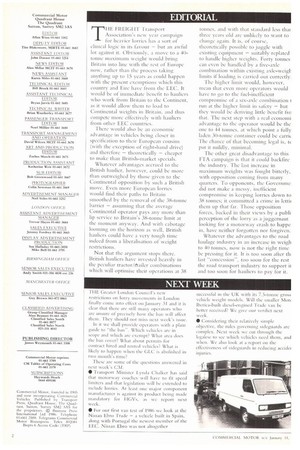T HE FREIGI IT Transport Association's new year campaign for heavier
Page 2

If you've noticed an error in this article please click here to report it so we can fix it.
lorries has a sort of clinical logic in its favour — but an awful lot against it. Obviously. a move to a 40tonne maximum weight would bring Britain into line with the rest of Europe now, rather than the process taking anything up to 15 years as could happen with the present exemptions which this country and Eire have from the EEC. It would be of immediatebenefit to hauliers who work from Britain to the Continent, as it would allow them to load to Continental 1,veights in Britain, and thus compete more ettectively with hauliers from other EEC countries.
There would also be an economic advantage in vehicles being closer in specification to their European cousins (with the exception of right-hand drive) and therefore — theoretically — cheaper to make than British-market specials.
Whatever advantages accrued to the British haulier, however, could be more than outweighed by those given to the Continental opposition by such a British move. Even more European lorries would find their paths to Britain smoothed by the removal of the 38-tonne barrier — assuming that the average Continental operator pays any more than hp service to Britain's 38-tonne limit at the moment anyway. And with cabotage looming on the horizon as well, British hauliers could have a very tough time indeed from a liberalisation of weight restrictions.
Not that the argument stops there. British hauliers have invested heavily in the peculiar tractor/It:tiler combinations which will optimise their operations at 38 tonnes, and with that standard less thou three years old are unlikely to want to change again. It is, or course, theoretically possible to juggle with existing equipment — suitably replaced to handle higher weights. Forty tonnes can even be handled by a five-axle combination within existing axle-weigh limits if loading is carried out correctly.
The higher limit would, however, mean that even more operators would have to go to the fuel-inefficient compromise of a six-axle combination 1 run at the higher limit in safety — but they would be deriving little benefit fro that. The next step with a real economi advantage to the operator would be the one to 44 tonnes. at which point a fully laden 30-tonne container could be carric The chance of that becoming legal is, to put it mildly, minimal.
The other great disadvantage to this FTA campaign is that it could backfire the industry. The last increase in maximum weights was fought bitterly, with opposition cooling from many quarters. To opponents, the Governme: did not make a messy, inefficient compromise in keeping lorries down to 38 tonnes; it committed a crime in lath them up that far. Those opposition forces, backed in their views by a publi perception of the lorry as a juggernaut looking for a motorway crash to happc: in, have neither forgotten nor forgiven.
Whatever the advantages to the road haulage industry in an increase in weigh to 40 tonnes, now is not the right time be pressing for it. It is too soon after thi last "concession, too soon for the rest the road transport industry to support it and too soon for hauliers to pay for it






















































